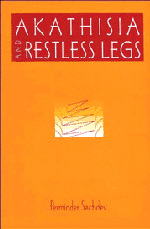Book contents
- Frontmatter
- Contents
- Foreword
- Acknowledgements
- Abbreviations
- Part I Introduction
- Part II Drug-induced akathisia
- 4 The definition of drug-induced akathisia
- 5 Epidemiology
- 6 Clinical characteristics and diagnosis of acute akathisia
- 7 Clinical characteristics of tardive and chronic akathisia
- 8 Akathisia due to a general medical condition
- 9 Assessment and measurement of akathisia
- 10 Aetiology and pathogenesis of akathisia
- 11 Treatment of drug-induced akathisia
- Part III Restless legs syndrome
- Part IV Conclusions
- Appendix A Haskovec's Akathisie
- Appendix B Prince Henry Hospital Akathisia Scale
- Appendix C Barnes (1989) Akathisia Rating Scale
- Appendix D Hillside Akathisia Scale (version 4)
- References
- Index
8 - Akathisia due to a general medical condition
from Part II - Drug-induced akathisia
Published online by Cambridge University Press: 12 September 2009
- Frontmatter
- Contents
- Foreword
- Acknowledgements
- Abbreviations
- Part I Introduction
- Part II Drug-induced akathisia
- 4 The definition of drug-induced akathisia
- 5 Epidemiology
- 6 Clinical characteristics and diagnosis of acute akathisia
- 7 Clinical characteristics of tardive and chronic akathisia
- 8 Akathisia due to a general medical condition
- 9 Assessment and measurement of akathisia
- 10 Aetiology and pathogenesis of akathisia
- 11 Treatment of drug-induced akathisia
- Part III Restless legs syndrome
- Part IV Conclusions
- Appendix A Haskovec's Akathisie
- Appendix B Prince Henry Hospital Akathisia Scale
- Appendix C Barnes (1989) Akathisia Rating Scale
- Appendix D Hillside Akathisia Scale (version 4)
- References
- Index
Summary
Some neurological disorders may be associated with the development of a syndrome resembling DIA. We will refer to this syndrome as akathisia due to a general medical condition, in keeping with the nomenclature adopted in the fourth edition of the Diagnostic and Statistical Manual of Mental Disorders (DSM-IV) (American Psychiatric Association, 1994). The akathisia in this case is judged to be a direct physiological consequence of the neuroleptic disorder, in the absence of a drug that could be causative. Using earlier nomenclature (eg, DSM-II-R, American Psychiatric Association, 1987), this syndrome would most appropriately be termed organic akathisia.
A review of the published literature suggests the following neurological causes of akathisia: (i) encephalitis lethargica and postencephalitic parkinsonism, (ii) PD, (iii) traumatic brain injury or (iv) subthalamic abscess.
Encephalitis lethargica and postencephalatic parkinsonism
Most neurologists are aware of the epidemic of encephalitis lethargica (EL; also called ‘sleeping sickness’), which started in 1916–1917 and raged for about 10 years, becoming worldwide. Innumerable cases and small epidemics of a similar disease had been described for many centuries. The infectious nature of EL was demonstrated by Constantin von Economo, who was able to transmit the disease to monkeys, but the presumed viral agent has never been isolated. The outcome varied from death in about 25% of cases to complete recovery, but a number of patients showed postencephalitic sequelae affecting both cognitive faculties and motor control, with parkinsonism being most common (von Economo, 1931).
- Type
- Chapter
- Information
- Akathisia and Restless Legs , pp. 181 - 187Publisher: Cambridge University PressPrint publication year: 1995



